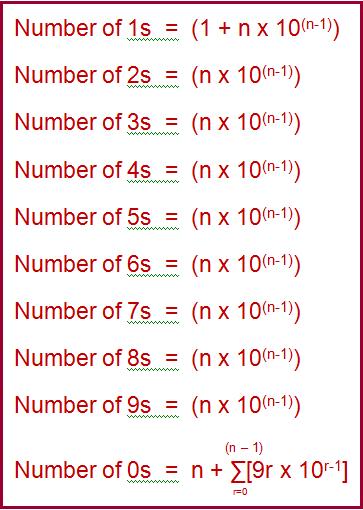| Answer: This can be figured out using permutations concept. For example, from 1 to 100 count, |
| we find one 1 in hundreds place, placing 1 in tens place can form 10 possible combinations (like 10, 11 ... 19), |
| placing 1 in units place can form 10 possible numbers (like 11, 21, 31, ... 91). So all together 1 appears 21 times. |
| If we take 2, it can't be placed in hundreds place. When arranged in units and tens place yield 10 and 10 possible numbers respectively. |
| So 2 appears 20 times. Similarly 3, 4, 5 ... 9 appears 20 times each. Zero in units place can yield 9 two-digit numbers (like 10, 20, ... 90). |
| Zero in units and tens place can yield one number, which is 100. So zero appears 11 times. |
| Ultimately adding all these (21 ones, 20 of twos, threes, ... nines, 11 zeros equal to 192) equals to number of digits from 1 to 100 |
| ( 9 single digit numbers, 90 two digit numbers and 1 three digit number adds up to 9 + 90x2 + 3= 192) |
| Generalizing the formula, for a number with n zeros after 1 (Example 100000000, where n=8 |
 |
| Winners: Sravya Ainapurapu. |



